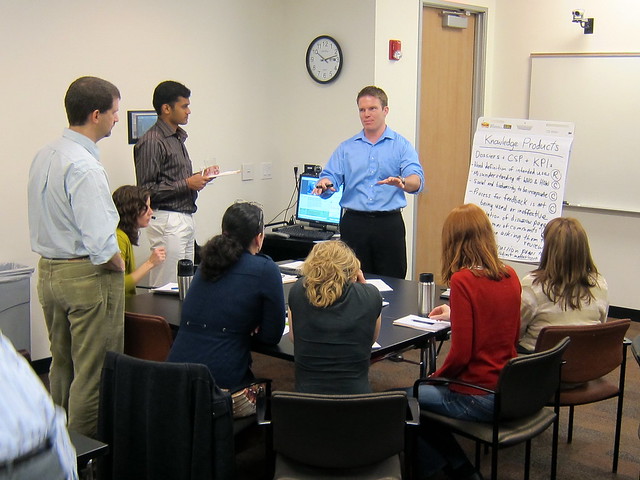
We have all been helpless and hapless victims or been held hostage to the time-suck of non-productive meetings. Some meetings happen simply because they are seemingly etched in stone on the schedule, and we feel we compelled to have them. Some meeting are called by people, I think, to alleviate their own personal boredom or to try to breakthrough some sticking point in a project.
Occasionally, you will get called upon or have the opportunity to lead meetings as part of your job or volunteer activities. Having been in meetings that don’t work, you of course, want to do a better job. You want to make the most of your time to shine.
Job #1 must be to make the meetings pleasant and productive by learning how to:
- Help people stick to the agenda
- Help people feel engaged
- Help everyone stay focused.
Below are a few suggestions for coping techniques to deal with those tricky situations that may occur during your meetings and will help you lead meetings accomplish their purpose in record time.
General Guidelines for Facilitating Meetings
1. Stick to the schedule. Among the most common complaints about meetings are a failure to stick to the schedule and the efficient use of time. Time is money as they say. One of the easiest ways to eat away at your credibility is to abuse people’s time on a regular basis. It’s important to start and end on time. Appoint a timekeeper to back you up if you have difficulty in this area.
2. Circulate an agenda. Make it easier for people to come prepared by circulating a detailed agenda in advance. Review it at the start of the meeting for any additions or changes that need to be made. Set a maximum time for each topic so that you stay on track. This may not always seem practical, but start with a set goal in mind. The time allotted for the total meeting should be set in stone. This gives you additional incentive to stay on task.
3. Tailor your facilitation style to the group. The best approach depends on the experience and preferences of the group you will be working with. Some organizations may follow strict protocols, like Robert’s Rules of Order, while others enjoy less formal discussions.
4. Set ground rules. Prevention is usually the best strategy for dealing with possible conflict. If you know that disagreements are likely to occur, use the ground rules to encourage respectful and constructive dialog. Another suggestion is to be tough on issues rather than on people.
5. Check the equipment before the meeting begins. Ensure that your laptops, microphones and conference call lines are working before the meeting starts. People are likely to mentally wander off if you spend too long debating how to advance the slides, or if your laptop goes into hibernation just when you need it most.
6. Focus on objectives. Identify objectives for each agenda item. Develop action plans for implementing decisions. Always put an action to each objective. Assign responsibilities for follow-up tasks. Set up accountability markers– who, what, when, etc.
Coping Techniques for Common Challenges
1. Get people talking. Give everyone a chance to contribute. Go around the room or table. Ask to hear from people who haven’t spoken yet. Watch for facial expressions or body language that suggests someone may be waiting for an opening to chime in.
2. Learn to politely shut people down. Stop people from talking too much, and from talking about non-agenda items. If a handful of people are dominating the conversation, use your ground rules to establish a speaking order. Tactfully encourage people to wrap up their long speeches. Dividing into small groups may also help to balance the discussion.
3. Remain neutral. Remember that you are the facilitator. The role of a facilitator is to enable a productive group process and open discussion. Stay objective to avoid imposing your own personal opinions. This is especially important because, as a facilitator, your statements may carry more weight than you realize.
4. Overcome impasses. If you sense that there’s going to be trouble reaching a consensus, try pointing out the common ground and agreements that have already been reached. Poll the group before taking a vote to see if more discussion is needed to reach a decision. Suggest tabling topics that seem resistant to being resolved quickly. You can appoint a committee to study them further and report back; don’t forget the accountability markers.
5. Minimize distractions. Having a meeting is difficult when everyone is texting. Start off with an announcement to turn phones off and to please step outside for emergency calls. As any teacher knows, side conversations will usually subside if you wander over in the participants’ direction.
6. Take time for team building. If the group is unfamiliar with each other or lacks cohesion, do a round of introductions and consider playing some icebreaker games. Serving lunch or snacks will provide some social time together. And this should ease some of the tensions as well.
Be the facilitator!
Skillful facilitation creates an environment where all meeting participants can feel comfortable working together toward their common goals.
You can help everyone feel like they can contribute, manage conflicts with finesse, and guide the discussion toward the outcomes that the group is seeking. When you do, you’ll become a valued facilitator and will be pleased with the results!
Thoughts or suggestions?
What would you add to this list?
photo credit: http://www.flickr.com/photos/pagedooley/6861256042/sizes/z/in/photostream/








